News
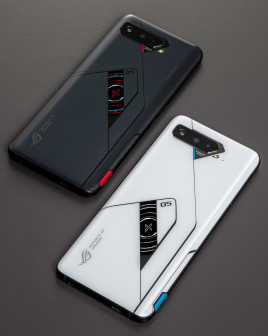
Asus ROG Phone 5 Maxes Out Specs, Adds a Rear Display
Asus today announced the ROG Phone 5, its newest flagship gaming phone, following the ROG Phone 3. The ROG Phone 5 brings the ROG Phone series up to date for 2021 with a Snapdragon 888 chip, Android 11, and 65-watt fast charging for its huge 6,000 mAh battery. The AMOLED display is also brighter and larger at 6.78 inches, and has an industry-leading 300 Hz touch sampling rate. The display specs are otherwise similar to the ROG Phone 3: 144 Hz refresh, HDR10+, and FHD+ resolution. The ROG Phone 5 will come in three versions. The standard model is available with 8 or 16 GB of RAM and 128 or 256 GB storage. A Pro model adds a small full-color display to the back, set at an angle, to show "customizable animations in response to a variety of system and in-game events". It's also available with up to 512 GB of storage. An Ultimate model steps up to 18 GB of RAM, and has a monochrome rear display. All three models use high-performance LPDDR5 RAM and UFS 3.1 storage. All three models also have sub-6 GHz 5G and will come in a North American version with support for nearly all of the 4G and 5G frequency bands used in the US, including band 77 for forthcoming C-band 5G networks. The ROG Phone 5 is the first in the series without an obvious air vent on the back for cooling, although Asus claims that its "GameCool 5" cooling system is "upgraded" to keep the processor from thermal throttling. The phone also has upgraded wireless, supporting Wi-Fi 6e and Bluetooth 5.2. A number of specs and features remain unchanged from the previous model, including the exact same array of cameras: 64 megapixel main, 13 megapixel wide, 5 megapixel macro, and 24 megapixel front camera. Other signature ROG Phone features remain, such as AirTrigger shoulder controls, front-facing stereo speakers, and an extra USB-C port on the side, for comfortable landscape gaming while charging. A 65W fast charger is included, and the phone also supports the Quick Charge 5.0 and USB-PD 3.0 fast charging standards. ASUS ROG Phone 5 series will be available in North America starting next quarter.
Dish Buys Republic Wireless
Dish is acquiring Republic Wireless and its 200,000 customer relationships. This will help grow Dish's customer base beyond Boost customers. Both Republic and Boost use T-Mobile's network, but Dish is working toward building its own 5G network from scratch. The deal is subject to closing conditions and regulatory approvals, and is expected to close in the second quarter of 2021. "Once acquired by DISH, Republic customers will not see any immediate changes to their experience or plans, and there is no need for customers to take action."
Apple Launches Tool to Copy Your Photos from iCloud to Google Photos
Apple has taken the unusual step of making it easier to switch from an iPhone to Android by launching a new web tool that helps you copy photos and videos stored in iCloud Photos to Google Photos. Available at privacy.apple.com, the service supports photos, videos, and basic albums, including a variety of file formats and "some" RAW files. The service does not support Smart Albums, Live Photos, and certain RAW files. Also unsupported are shared albums, photo stream content, and certain metadata. The process takes three to seven days, and Apple renames albums and videos to start with "Copy of ".
/e/ Starts Selling "De-Googled" Samsung Phones in US
Esolutions has started selling privacy-focused phones preloaded with the /e/ OS in the US. The /e/ OS is based on an open-source version of Android 10 (LineageOS, specifically) without any Google-controlled services that would enable tracking and data scanning by Google or third parties. /e/ replaces Chrome with its own Chromium-based browser, Gmail with K-9 Mail, and has its own app store and cloud storage service. Many popular third-party apps rely on Google Play Services for important functions like push notifications. /e/ OS includes a dummy API called MicroG to ensure such third-party apps don't crash, but those features like push notifications remain non-functional. Esolutions has offered phones pre-loaded with /e/ OS in Europe for some time, but has just started sales in the US for the first time. There are two refurbished Samsungs to choose from: a Galaxy S9 for $380, or a Galaxy S9+ for $430. The phones come with a one-year warranty and the e Foundation says "We aim to support with at least 3 years of software updates and security patches." The /e/ OS is also available for download for a number of other Android phones.
Qualcomm Takes on Apple's Bluetooth Performance with Snapdragon Sound
Qualcomm has introduced a new initiative called Snapdragon Sound that aims to improve sound quality, battery life, and latency of Bluetooth earbuds powered by new Qualcomm chips when used with phones that are also powered by new Qualcomm chips. Snapdragon Sound also promises to improve the robustness of the Bluetooth connection and make pairing easier. Snapdragon Sound is a suite of many tweaks and optimizations made at nearly every level of hardware and software, from end to end of the phone+earbuds system. Snapdragon Sound seems to be Qualcomm's answer to the improved Bluetooth performance that Apple has been able achieve with its custom Bluetooth chips in AirPods and iPhones. Qualcomm says Snapdragon sound will offer better sound quality in the form of double the sampling rate compared to Apple for both music (96 kHz instead of 48) and voice calls (32 kHz instead of 16). Qualcomm also claims 45% lower latency compared to Apple. Devices bearing the Snapdragon Sound branding must pass a series of quality, performance, and interoperability tests in a new facility Qualcomm has established in Taiwan. The first Snapdragon Sound devices should hit the market "before summer".
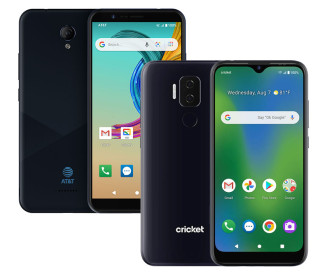
VinSmart Enters US Market with Two Sub-$100 Phones for AT&T
Vietnamese manufacturer VinSmart has officially entered the US phone market thanks to a deal with AT&T for "nearly 2 million smartphones". AT&T (and its Cricket prepaid brand) recently started selling two distinct entry-level phone models from VinSmart. Both are under $100 and are white-labeled, meaning they bear the AT&T or Cricket brand (instead of VinSmart or its Vsmart brand). AT&T has turned to Chinese manufacturer Tinno for such phones in recent years. But with the US government's hostile posture toward Chinese telecom companies in the last few years, AT&T may be looking to diversify its suppliers beyond China. The more affordable of the two models is the AT&T Fusion Z. It has a 6-inch HD display and USB-C, but its specs are otherwise minimal, including Android Go Edition, a Snapdragon 215 chip, and a 5 megapixel main camera. AT&T Prepaid shows the list price as $80 but is selling it for $40. Walmart is selling the same phone as the "Motivate" for $50. The slightly higher-end model is the Cricket Influence, which runs full Android 10 thanks to 3 GB of RAM and 32 GB of storage. It's powered by a Qualcomm Snapdragon 460 chip. Features include a fingerprint reader, modern notched HD display with Gorilla Glass 3, and a 13-megapixel camera plus depth camera for portrait mode. Both phones have a headset jack and memory card slot. Cricket shows a list price of $110 for the Influence, but is selling it for $40 to both new and existing customers. Walmart is selling the same phone for AT&T Prepaid as the AT&T Maestro Plus, for $90. The original "AT&T Maestro" was manufactured by Tinno.
Verizon Just Spent $45 Billion on New 5G Spectrum
The FCC today announced the winners of Auction 107 for radio frequency licenses in the coveted "C-Band". Verizon spent $45.5 billion, well over half the $81.1 billion total spent in the whole auction. All major US carriers spent large amounts, with AT&T spending $23.4 billion, T-Mobile spending $9.3 billion, and US Cellular spending $1.3 billion. Auction 107 is for radio frequencies spanning 3.7 to 3.98 GHz. This band is unusually large at 280 MHz wide, giving it valuable high capacity for many users and/or fast data speeds. Spectrum in these "mid-band" frequencies is also valuable because it's ideal for building 5G networks that offer a good balance of fast data speeds and broad coverage. Most current 5G networks in the US offer only fast speeds or broad coverage, an issue that is particularly acute for Verizon at the moment. Auction 107 is likely to be the largest and most important of several C-band auctions the FCC is holding. Auction 105 was the first, though it raised only $4.6 billion. The next will be Auction 110, for 3.45 – 3.55 GHz. The FCC finalized its proposed rules for that auction earlier this week.
Android Auto Adds Games, Wallpaper, Split-Screen View
Google is rolling out a major update to Android Auto. The new version includes car-optimized games such as trivia and "Jeopardy!". The feature can be activated by saying "Hey Google, play a game". Users can now "select from a variety of car-inspired backgrounds to personalize your car display". Finally, on "cars with wider screens", a new split-screen view "features a real-time view of Google Maps and media controls". The update will be available in the coming days for phones with Android 6 and above.

Google Now Lets You Schedule a Text in Messages
Google has started rolling out an update to it Messages app that lets users schedule a text message to send at a later time. The feature is designed for people with "loved ones in another time zone or on a different schedule". To use the feature, simply press and hold the send button to reveal a new pop-up menu for scheduling. The menu provides several suggested times as shortcuts, plus an option to pick any specific date and time. The feature will be available in the next Messages update for phones running Android 7 and newer.
Samsung's New 50-Megapixel Camera Sensor Supports Staggered HDR
Samsung today announced a new camera sensor featuring a number of new technologies that will offer improved HDR, low-light performance, and auto-focusing. The ISOCELL GN2 is a 50 megapixel sensor with 1.4-micrometer (μm)-sized pixels. The GN2 supports staggered HDR, which lets a device capture short and long exposures simultaneously, for HDR images with fewer motion artifacts. Staggered HDR can also enable computational HDR for video. Support for staggered HDR sensors is a key feature of Qualcomm's latest flagship chip for phones, the Snapdragon 888. Samsung also claims that staggered HDR is 24% more power-efficient compared to the traditional HDR technique. The GN2 also sports Dual Pixel Pro, an improved auto-focus (AF) system that uses all sensor pixels for focusing. While previous dual-pixel AF systems can only detect pattern changes horizontally, Dual Pixel Pro splits pixel elements diagonally, so it can also use vertical information to lock focus quickly. The GN2 also has Smart ISO Pro, which does for ISO what staggered HDR does for exposure length. The technology "takes readouts from both high and low ISO to instantly create high dynamic range images with less motion-artifacts." It can also take and process multiple high-ISO frames quickly, for an effective maximum ISO of "close to one-million". For video, the GN2 supports full-HD videos at 480 frames-per-second (fps) or 4K at 120fps. The ISOCELL GN2 is already in mass production, meaning it should make its way into phones soon.
T-Mobile Redefines Premium Plans with Fully Unlimited Data
T-Mobile today introduced a new premium service plan called "Magenta Max", that offers truly unlimited "premium" (full-speed 5G or 4G) data. Before today, T-Mobile's top-end "Magenta Plus" plan offered up to 50 GB of full-speed data, after which speeds could be restricted. Magenta Max will replace Magenta Plus on February 24th. T-Mobile is also improving the mid-range Magenta plan to offer 100 GB of full-speed data (up from 50). Magenta Max offers 40 GB of high-speed hotspot data (double the 20 GB offered on Magenta Plus), while the high-speed hotspot allotment on Magenta is being upgraded from 3 GB to 5 GB. Magenta Max also offers unlimited 4K video, 2x data speeds (compared to 2G) while roaming internationally, unlimited Gogo in-flight Wi-Fi, Scam Shield Premium, and NetFlix Standard included (instead of Netflix Basic) on family plans. Magenta Max has the same pricing as the Magenta Plus plan it replaces: $85/month for a single line, with AutoPay discount, taxes & fees included. Family-plan discounts bring that down to $70/line for two lines, $57/month for three lines, $50/month for four lines, or as little as $40/month for eight lines. A limited-time offer brings three lines down to $47/month/line, and a similar discount brings the standard Magenta plan down to $40/line/month for three lines.
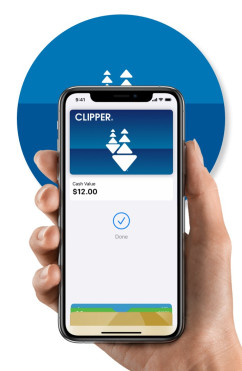
San Francisco's Clipper Transit Card Coming to Apple Pay, Google Pay
Clipper Card — the universal transit fare card for all 24 San Francisco Bay Area transit agencies — will be supported in Apple Pay and Google Pay digital wallets "this spring". Residents and visitors will be able to add a stored-value Clipper card to their digital wallet and tap their phones to ride transit, replacing a physical Clipper card. The system differs from those in cities (such as New York and Chicago) offering "open" fare payments made directly from a credit or debit card in Google Pay / Apple Pay. Apple has launched a page where people can sign up to be notified when Clipper is available for iPhone and Apple Watch. Separately, Google announced a new feature of Google Maps that lets users buy and present transit fare payments — including Clipper, when available — without leaving the Maps app, as part of turn-by-turn directions that include transit.
Verizon, Google Offer New Intro Deals on Plans
Google Fi and Verizon Prepaid recently launched new introductory deals for new customers / added lines. Verizon Prepaid is offering the third month of service for free, while Google is offering half off the first three months of service. Verizon also offers "loyalty" discounts that kick in starting on the fourth month.
Samsung Commits to Four Years of Security Updates for Galaxy Devices
Samsung today made a new commitment to provide security updates for its Galaxy phones and other devices for "a minimum of four years after the initial phone release." The promise covers phones launched in 2019 and later, including the S10 series, Note10 series, Z series, Fold, A50, A20, A10e, as well as newer models launch in 2020, 2021, and onward. Security updates protect users from security vulnerabilities discovered after launch. Such discoveries are relatively common. That means the longer a device has gone without a security update, the more vulnerable it is to hacking and malware. Security updates alone generally do not add new features nor update to a new OS version. Samsung made a separate commitment last August to provide three full OS upgrades for its higher-end Galaxy devices.
Apple Won't Let Just Anyone Offer a "Vaccine Passport" App
Apple has added a new App Store rule for "health pass" apps "based on testing and vaccination records". Commercial developers of such apps must prove that they are "working with entities recognized by public health authorities, such as test kit manufacturers, laboratories, or healthcare providers." The rule is intended to prevent fraudulent digital vaccine passports, ensuring valid ones can be trusted.

Samsung Adds New Features to Older Galaxy Phones
Samsung today announced the availability of its One UI 3.1 software update, which brings select software features of the new Galaxy S21 series to most higher-end Galaxy phones from 2020 and 2019. New features include an improved "Single Take" camera mode, which captures a variety of still and video formats simultaneously. It also brings Object Eraser (shown), an intelligent photo editing tool to cut out unwanted parts of photos. "If you want to edit out distracting objects, simply tap the area you wish to remove and it will be automatically selected and deleted." Other new features include Private Share, to control who is allowed access to the content you send and how long it is available, and Eye Comfort Shield, which automatically adjusts the display's blue light output based on the time of day. Finally, there's Multi Mic Recording, which, when in Pro Video mode, allows you to simultaneously record audio through both your phone and a connected Bluetooth. The One UI 3.1 update is available starting today for the following Galaxy phones: S20 series, Note20 series, Z Fold2, Z Flip, S10, Note10, Fold, A71, A51, A90, A80, A70, and A50. All of those phones will receive the new Single Take, Object Eraser, Private Share, and Eye Comfort Shield features. Multi-Mic Recording will only be available on 2020 flagship phones: Galaxy S20 series, S20 FE, Note20 series, Z Fold2, and Z Flip 5G.

Android 12 Released to Developers
Google has released the first preview version of Android 12 to developers. As a developer release, it focuses on APIs and other developer-focused aspects, rather than necessarily representing the final look and feature set for consumers. Several new features are notable, though:
- Project Mainline continues to expand, with Google adding the Android Runtime (ART) module to the list of software that Google can update directly through the Play Store, instead of requiring a full OS update approved by manufacturers and carriers. ART handles compiling app code into processor instructions.
- Better support for newer image and video formats. Specifically, support for the AV1 image file format (AVIF), and better support for the HEVC video format.
- Rich content insertion, which makes it easier for apps to support copy-and-paste of styled text and multimedia. The new API for rich content also supports drag-and-drop.
- Haptic-coupled audio effect, which lets apps more easily add haptic effects by linking them to an audio channel.
- Multi-channel audio, including support for spatial information encoded with MPEG-H, and enabling apps to mix and process up to 24 audio channels.
- Finally, the Notification UI has been updated to make "custom" notifications look and work more like other notification types.
Essential Goes to Nothing
Nothing, Technologies, a new startup from former OnePlus executive Carl Pei, has purchased the Essential brand. Essential was a phone startup founded by Android creator Andy Rubin after he left Google.
2021 Motorolas Start Hitting Carrier Stores
Metro by T-Mobile today announced the launch of the Motorola one 5G ace, a relatively affordable 5G phone at just $280, a significant discount from the $400 Motorola charges for the unlocked version. T-Mobile will also launch the one 5G ace soon. The more-affordable moto g play (2021) also just launched on both T-Mobile and Metro, for $150 and $160, respectively. Motorola charges $170 for the unlocked version. Separately, Cricket just launched the moto g power (2021) for $120 (plus $25 upgrade fee for existing customers). The g power sells for $250 unlocked. Metro is offering launch deals on the Motorola 5G ace for a limited time: New customers can get the phone for just $20, while existing customers adding a line can get the phone for $90. All three phones were announced in early January and went on sale unlocked January 14th.
Google Photos Gains New Video Editor, Plus Extra Features for Google One Members
Google today announced a new video editor as part of Google Photos. The company also announced that some advanced, AI-powered features previously available only on Pixel phones will now be available on more phones, but only for Google One subscribers. The new video editor adds features to "crop, change perspective, add filters, apply granular edits (including brightness, contrast, saturation and warmth) and more." This is in addition to existing features to trim, stabilize and rotate videos. It's available now in Google Photos for iOS, and "will be rolling out to most Android users in the coming weeks". In the coming months, iOS users will also get the revamped photo editor that rolled out to Android users late last year. Google One subscribers on Android will also get several new features that were previously restricted to Pixel phones. In the coming days, those users will see an updated Google Photos app that includes Portrait Blur, Portrait Light, and new "Dynamic" and "sky" filters. All of these new feature use machine learning to apply advanced effects in a realistic way to any photo, including those captured without depth information. Google One memberships start at $2/month.
Court Rules CBP Agents Can Search Your Phone Without a Warrant
A US appeals court has issued a new ruling declaring that Customs and Border Protection agents can conduct both basic and "advanced" searches of electronic devices at US borders without needing a warrant nor reasonable suspicion. The new ruling overturns a district court decision from January 2020 that ruled such searches unconstitutional. In the new ruling, First Circuit Judge Sandra Lynch says "Electronic device searches do not fit neatly into other categories of property searches, but the bottom line is that basic border searches of electronic devices do not involve an intrusive search of a person". Although the the rules for border searches are intended for persons entering at border crossings, they technically apply to all CPB agents working within 100 miles of any US border, which includes many major US cities. The ACLU, which backed the lawsuit in question, issued a statement: "We are disappointed with the ruling and evaluating all options to ensure we don’t lose our privacy rights when we travel."
Google Fi Extending Free VPN to iPhones
Google Fi today announced that its free VPN service is exiting beta for Android, and will "roll out ... to iPhone starting this spring." The VPN service protects against IP address tracking and hacking while using unsecure Wi-Fi networks.
Motorola Taps Bullitt for New Lineup of Rugged Phones
Bullitt Group will soon launch a new range of rugged mobile phones bearing the Motorola brand. Bullitt specializes in rugged phones, and already makes rugged phones for the CAT and Land Rover brands. This long-term "strategic brand partnership" gives Bullitt the exclusive global license to develop and market rugged mobile phones bearing the Motorola brand. In this "unique strategic alliance", "Motorola and Bullitt will combine their expertise". Although Bullitt will lead the development and marketing, the phones "must meet Motorola's strict quality, safety, and reliability standards, and Motorola also maintains 100% control over merchandising, marketing and customer experience". Bullitt will reveal details of the first phones (plural) from this partnership later this quarter.
Visible Revamps Plans, Launches 5G and eSIM
Visible just launched a variety of new service offerings and revamped plans. Customers with compatible phones can now access Verizon's 5G network at no extra cost. The company's unlimited voice service now includes calling to Canada, Mexico, US Virgin Islands, and Puerto Rico. Visible also now supports phone activation via eSIM on iPhones launched in 2018 (Xs and Xr) and newer, "with Android devices coming soon". Finally, the company has tweaked its Party Pay plans and added a referral program. Whereas Party Pay shared plans were previously capped at four people, they are now unlimited, with groups of four or more paying $25/month each. The company has also launched a community forum to help people find Party Pay groups to join. (The company does not require that groups be related, and in fact nearly one third of all customers using Party Pay are in a group with someone they don't know.) The referral program reduces your bill to $5 the month after you refer a new customer.
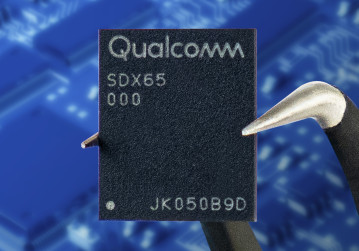
Qualcomm Intros 10 Gigabit 5G Modem
Qualcomm today introduced a suite of new modem and radio chips to power the next generation of higher-end 5G phones and devices. The company's new flagship 5G modem chip is the Snapdragon X65 5G Modem-RF System, which is the first in the world to support data rates of up to 10 Gbps. The company also introduced the X62, a chip for slightly more mainstream phones that supports up to 4.4 Gbps. Both chips are made with a cutting-edge, power-efficient 4nm manufacturing process. They support all the features of the company's existing X60 modem, including 5G carrier aggregation (CA) with mmWave and sub-6 GHz bands. The X65 and X62 support the new 3GPP Release 16 standard, or "5G Phase 2", and have an "innovative" architecture that allows new features of the Rel. 16 standard to be added via software update. The company also introduced a full suite of companion RF chips and a new, fourth-generation mmWave antenna module. The new 545 mmWave antenna module supports higher transmit power for extended mmWave 5G coverage. The suite of chips includes a new feature called Qualcomm AI-Enhanced Signal Boost, which brings AI to antenna tuning for the first time. This uses AI to understand radio "context" (hand position, mostly) with 30% better accuracy, allowing better antenna tuning, which in turn means "faster data speeds, better coverage and longer battery life." The Snapdragon X65 and X62 are sampling to manufacturers now and "expected to be in commercially available 5G devices in late 2021."
Motorola Sale Brings Verizon razr to just $500
Motorola and Verizon are running a Valentine's Day sale offering a $500 discount on the flex-screen razr (2019) and the 5G edge+. Both are normally priced at $1000, so the discount cuts the price in half, to just $500. That is, by far, the lowest price for a foldable phone to date. This discount is available to both new and existing customers, and does not require a new line nor trade-in, but it does require a "select unlimited plan" and is only available online. The sale started February 4th and runs through February 14th. Further discounts can lower the price to zero with an eligible phone trade-in. The companies are also offering a buy-one-get-one-free (BOGO) deal on the edge+ "with new line activation and premium unlimited plan."
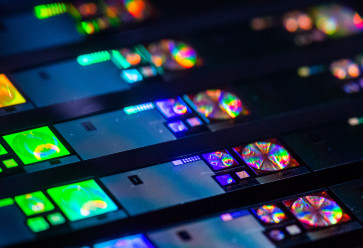
New Flat Lens Tech Means Smaller, Better 3D Sensors in Phones
A new company called Metalenz has developed a unique flat lens technology that is well on its way to revolutionizing the infrared 3D depth cameras used in many phones. The flat lens technology is much smaller than the traditional lens systems, and offers better performance. In both ToF cameras and Structured Light systems (such as Apple's Face ID), Metalenz technology offers better optical efficiency that translates to better power efficiency and longer battery life. It can also "result in a face identification that works better, particularly when the person is further away from the phone or in sunlight." The company's flat lenses are made using semiconductor technology similar to that used to make microchips, simplifying the supply chain. The lens itself uses meta-optics, or optical metasurfaces, consisting of patterned structures 1000x smaller than a human hair. The technology was originally developed at Harvard's John A. Paulson School of Engineering and Applied Sciences (SEAS). Harvard has granted Metalenz an exclusive worldwide license to the technology. Metalenz was founded in 2017 and emerged from stealth mode this week, announcing $10 million in funding from 3M, Applied Ventures, Intel Capital, M Ventures, and TDK. According to Wired, the "company has formed partnerships with two semiconductor leaders (that can currently produce a million Metalenz 'chips' a day)", and "Metalenz will go into mass production toward the end of the year. Its first application will be to serve as the lens system of a 3D sensor in a smartphone." The company declined to name the phone's manufacturer.

Google Fit Gains Heart Rate, Respiratory Rate Measurement via Camera
A forthcoming update to Google Fit will allow the app to measure heart rate and respiratory rate using only a phone's camera. The update will be available next month. The feature will be available first for Pixel phones, "with plans to expand to more Android devices." To measure respiratory rate, the camera looks at your head and upper torso to detect "tiny physical signals at the pixel level — like chest movements". To measure heart rate, the user places their finger on the camera lens so the app can measure "subtle changes in the color of your fingers". While the features "aren’t meant for medical diagnosis or to evaluate medical conditions", Google has completed "initial clinical studies" to validate the features.
Samsung, Motorola Cut Foldable Prices
Samsung is permanently dropping the price of its Galaxy Z Flip 5G. Separately, Motorola is offering major discounts on its 2020 phones — including the 2020 razr with 5G — in the first half of February. The Samsung Galaxy Z Flip 5G is getting a $250 price cut, putting it at $1,200 unlocked or from AT&T. (T-Mobile is still offering the Z Flip 5G for $1,450.) Motorola is offering discounts on unlocked phones from today through February 14th in celebration of Valentine's Day. The razr (2020), edge, and one zoom are all on sale with $200 discounts. That brings the new razr down to the same $1,200 price as the competing Galaxy Z Flip 5G. Motorola is also taking $150 off the one fusion+ and one action. Finally, Motorola is offering $30–50 off last years' g-series models. All of Motorola's discounts are for its unlocked models and available through motorola.com, bestbuy.com, and amazon.com.
iOS 14.5 Offers a Way for Face ID to Work With a Mask
A beta version of iOS 14.5 introduces the ability for Face ID to unlock your phone even when wearing a lower-face mask, provided the user is also wearing an Apple watch. Face ID by itself offers reduced security in this new mask mode, but the presence of an authenticated, unlocked Apple Watch provides enough of an extra security signal to compensate. In the beta version currently available, the feature must be enabled manually in Settings. The beta software was first made available to developers on Feb. 1st, then to consumers on Friday, Feb. 5th. Apple has not announced when iOS 14.5 will exit beta testing.
DC Metro Offers Underground Cell Service Systemwide
The Washington Metropolitan Area Transit Authority today announced the completion of its project to offer cellular service in all 100 miles of underground tunnels and stations in the Washington, D.C. Metrorail system. Passengers can now receive uninterrupted AT&T, T-Mobile, and Verizon service on their phones throughout their entire journey. The project was mandated in a bill passed by Congress in 2008.
AT&T FirstNet Adds Unique Technologies for First Responders
AT&T today announced several unique new technological capabilities for its FirstNet offering for first responders. FirstNet offers priority access to AT&T's exclusive band 14 (758 - 798 MHz). Z-Axis location allows authorized applications that support Z-Axis to pinpoint FirstNet users precisely in three dimensions, not just on a map. For example, this gives a fire chief the ability to see exactly where firefighters are within a high-rise building. This feature uses the NextNav Pinnacle vertical positioning service, which AT&T has deployed in 105 markets across the country, with more added "weekly". The first app to support Z-Axis is Intrepid Networks' Response for FirstNet. LMR Interoperability for FirstNet Push-To-Talk bridges FirstNet PTT with traditional first responder radio systems that use LMR technology. This allows first responders to stay connected to their agency's central radio system even when outside the LMR network coverage area. 11 FirstNet-Ready phones support this feature via FirstNet PTT. Finally, AT&T is now offering a "Compact Rapid Deployable (CRD)" for sale directly to first-responder agencies. This Cell on Wheels (COW) can be deployed by a single person within a matter of minutes to create a band 14 LTE network anywhere in an emergency, including in remote areas and where mobile networks are temporarily down due to disaster. CRDs link to FirstNet via satellite. Until now, COWs have generally been owned and deployed only by mobile carriers, requiring extra coordination between carriers and first responder agencies during an emergency.
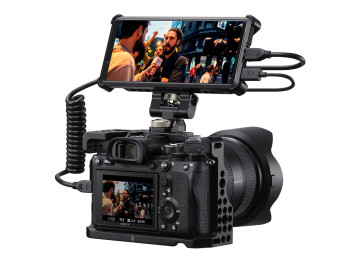
Sony Finally Launches its 5G Phone for Video, Photo Professionals
Sony today launched the Xperia Pro, a $2,500 phone designed specifically for video and photo professionals. The Xperia Pro has four mmWave 5G antennas for reliable connection to Verizon's Ultra Wideband 5G network (where available). This enables live broadcast of video and speedy upload of photos. It has unique wired input capabilities — including micro-HDMI — allowing it to connect directly to professional video and still cameras. The phone also comes with an External Monitor app for use with professional cameras. A "Network Visualizer" feature helps users find the strongest 5G signal for solid live video transmissions. The Xperia Pro was first announced last February. Since then, the specs have been boosted from 8 to 12 of RAM. Other specs are as initially announced, including 512 GB storage, memory card slot, Qualcomm Snapdragon 865 chipset, 4,000 mAh battery, and a 6.5-inch OLED display with HDR and unique 1644 x 3840 pixel resolution. Its built-in triple rear cameras are all 12 megapixel and include standard, telephotos, and wide lenses, aided by "3D iToF" and RGB-IR color sensors. Additional features include water resistance, NFC, Wi-Fi 6, fast charging, and front-facing stereo speakers. It's available starting today from B&H Photo.
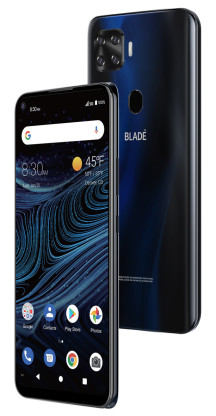
ZTE Brings Affordable 5G to Visible with the Blade X1 5G
ZTE and Visible today announced the ZTE Blade X1 5G, ZTE's first 5G phone for the US market. The Blade X1 offers sub-6 GHz 5G and solid mid-range specs for $384 from Visible. Visible operates on the Verizon network. The phone will also be available for Yahoo Mobile. Key specs include a 6.5-inch full-HD display, Qualcomm Snapdragon 765G processor, 6 GB RAM, 128 GB storage, 4,000 mAh battery, Quick Charge 3.0, and Android 10. It also sports a 48 megapixel main camera, an 8 megapixel wide-angle camera, and a 16 megapixel front camera. Other features include NFC, fingerprint reader, memory card slot, and headset jack.
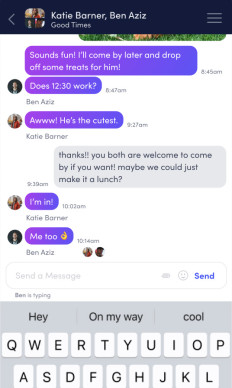
New Unified Messaging App Promises to Bring iMessage to Android
Beeper is a new $10/month app and service that unifies over a dozen different messaging services into one unified, searchable chat interface. It supports iMessage, Whatsapp, Facebook Messenger, Android Messages (SMS), Telegram, Twitter, Slack, Instagram, Skype, Discord, Signal, and more. It's available for iOS, Android, MacOS, Windows, and Linux. The service supports iMessage via one of two "bridge" methods: 1. the Beeper app running on a Mac that is always connected to the internet, or 2. "we send each user a Jailbroken iPhone with the Beeper app installed which bridges to iMessage". Beeper offers an open API called Matrix that enables bots, extensions, plugins, and integrations. The various "bridges" that power Beeper are open-source, enabling security audits as well as free self-hosting.
LG May Give Up on Phones
LG is "considering all possible measures, including sale, withdrawal and downsizing of the smartphone business", according to an internal memo that the company has confirmed is genuine. LG's smartphone business has lost $4.5 billion over the past five years.
Qualcomm's Snapdragon 870 is a Slightly Faster 865
Qualcomm today announced the Snapdragon 870, a new high-end chip that sits between the company's flagship chips of last year and this year (the 865 and 888, respectively) in terms of performance. In terms of architecture and features, it's almost identical to least year's 865, including having a separate 5G modem chip. (Most other Snapdragon chips, including the 888, have modem integrated into the main chip.) The key difference between the 865 and 870 is a boost of up to 10% in CPU and GPU performance. Commercial devices based on Snapdragon 870 are expected to be announced this quarter. Motorola and OnePlus are among the companies that have committed to using the 870.
5G C-Band Auction Wraps Up First Phase, Raising Over $80 Billion
The FCC today announced that its Auction 107 for C-Band spectrum has concluded its first phase, with final bids totaling $80.9 billion, shattering the record for any FCC auction. The auction made available licenses for 280 megahertz of spectrum in the 3.7 – 3.98 GHz band in the US. It is expected that wireless carriers snapped up most of the licenses and will use them to deploy expanded 5G networks that offer a better balance of coverage and speed than today's 5G networks, as well as additional network capacity for more users and faster data. This phase of the auction started in early December. In the next phase, winners in the first phase will be able to bid for specific frequency band slots. The FCC will announced the dates and details for that phase "soon".
Coalition Working on Vaccine Passport Standard for Digital Wallets
A group of companies including Epic, Mayo Clinic, Microsoft, Oracle, and Salesforce have teamed up as the Vaccination Credential Initiative (VCI), working "to enable individuals vaccinated for COVID-19 to access their vaccination records in a secure, verifiable and privacy-preserving way." VCI is working on a system that would allow individuals to obtain an encrypted digital copy of their immunization credentials to store in a digital wallet on their smartphone. A verifiable record of vaccination status will be a critical element in enabling people to safely return to work, school, events, and travel. The interoperable digital format is based on the open SMART Health Cards specification, based on W3C Verifiable Credential and HL7 FHIR standards.
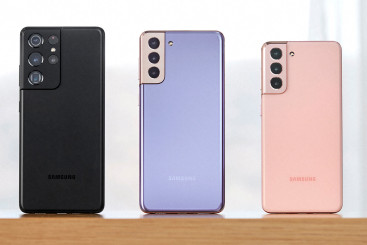
Samsung's Galaxy S21 Flagships are Prettier and More Affordable
Samsung today officially unveiled its Galaxy S21 series of flagship phones for 2021. All three models sport a distinctive new "Contour Cut Camera" design where the metal frame extends around one corner to surround the rear cameras. Each of the three new phones has a starting price a full $200 lower than last year's models. Samsung achieved this on the S21 and S21+ by reducing RAM from 12 to 8 GB and switching from curved QHD-resolution displays to flat FHD displays. Also, none of the S21 series has a memory card slot nor ToD depth camera. Naturally the processor has been updated on all models to Qualcomm's new flagship chip, the Snapdragon 888. Samsung is also using Qualcomm's new Gen 2. ultrasonic in-display fingerprint reader, which offers a 70% larger sensing area and is 50% faster. The phones ship with Android 11 and have a number of software improvements to the camera, such as Director's View, Vlogger View, and multi-mic recording. Samsung has also used AI to improve Single Take, Portrait Mode, and Space Zoom. The camera hardware on the S21 and S21+ is nearly identical to that on the S20 series. The S21 Ultra has the most-upgraded specs of the three, despite starting at a lower price than last year's model.
- Galaxy S21: The specs are very similar to last year's S20, including 4,000 mAh battery, 120 Hz refresh display, 64-megapixel main camera, 8K video capture, IP68 water resistance, fast wireless charging, and Wireless PowerShare. Unlike the S20, the S21 will come with mmWave 5G (including support for Verizon's "Ultra Wideband" network) from day one. It will come with 128 GB of storage, in Phantom Violet, Phantom Gray, Phantom Pink, and Phantom White, for $800. A 256 GB version will also be available in Phantom Gray for an extra $50. Phantom Gold and Phantom Red colors will be available exclusively from samsung.com.
- Galaxy S21+: Its 4,800 mAh battery is larger than that in both the S21 and last year's S20+. It also adds UWB for directional tag-finding and wireless car keys. This is the first time Samsung has put UWB in its S-series. It retains all of the other specs and features of the S21, with a larger 6.7-inch display like the S20+. It will come with 128 GB storage, in Phantom Violet, Phantom Silver, and Phantom Black, for $1,000. A 256 GB version will also be available in Phantom Black for an additional $50. As with the S21, samsung.com will be exclusive seller of Phantom Gold and Phantom Red colors.
- Galaxy S21 Ultra: This top-end model keeps the curved-edge, QHD-resolution display, 12 GB RAM, 108 megapixel main camera, and 40-megapixel front camera of last year's model, while adding several new features, all for a lower $1200 starting price. New this year is Wacom technology bringing full support for Samsung's S Pen, previously only offered on the Note series. The S Pen is an optional accessory. It also adds UWB, Wi-Fi 6e, adaptive display refresh from 10 – 120 Hz for power efficiency, and the ability to use 120 Hz refresh at QHD resolution. The telephoto camera system now includes dedicated 3x and 10x cameras, both 10 megapixel with OIS and dual-pixel auto-focus. All five cameras (front and back) can now shoot 4K video at 60 fps. The 108mp main sensor now has 12-bit HDR and can capture 12-bit RAW photos. It also has laser auto-focus. Pricing starts at $1,200 for 12 GB RAM / 128 GB storage in Phantom Silver or Phantom Black. Versions with 12 / 256 GB (for an extra $50) or 16 / 512 GB (for $1,380) will also be available, in Phantom Black only. Samsung.com exclusive colors will include Phantom Titanium, Phantom Navy. and Phantom Brown.
More articles in the Archive ›
What do you want to hear about? We're already working on a number of articles for the coming months, but we want to write about the things you're most interested in. So sound off: tell us what you want to know more about!













